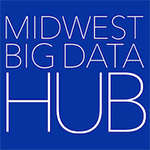by Keith Hollenkamp
In June of 2016, the Big Data Regional Innovation Hubs and Microsoft Research partnered to use the power of cloud computing to advance NSF-supported Big Data Spokes and Planning projects. This partnership involved Microsoft providing $3 million in Microsoft Azure cloud computing credits.
In the Midwest, part of these credits were awarded to three projects:
- Cloud Computing for neuroscience research; PI: Franco Pestilli, Assistant Professor at the Indiana University Bloomington College of Arts and Sciences’ Department of Psychological and Brain Sciences
- SEADTrain: Cloud-based, hands-on environment for online data science training; PI: Beth Plale, Professor at the Indiana University School of Informatics and Computing
- Cloud infrastructure for vision-based yield mapping; PI: Volkan Isler, Professor in Computer Science & Engineering at the University of Minnesota
At Indiana University, Franco Pestilli, assistant professor in the IU Bloomington College of Arts and Sciences’ Department of Psychological and Brain Sciences and co-director of the Advanced Computational Neuroscience Network, is using his credits to develop Brain Life, a cloud-based computing platform for neuroscience. Currently in its beta phase, Brain Life allows researchers in neuroscience, computer science, and engineering to share brain data and algorithm across institutions.
 Franco Pestilli. Indiana University
Franco Pestilli. Indiana University“By providing a framework where code and data can come together — seamlessly connected to a cloud-computing infrastructure — Brain Life will enable researchers to address critical issues of scientific reproducibility,” said Pestilli in an article on the Indiana University website. “It will also offer highly sophisticated technology to institutions and scientists with limited computing resources and data.”
Also at Indiana University, Beth Plale — Professor in the IU School of Informatics and Computing, Director of the Data To Insight Center, recent co-PI of the MBDH, and now Science Advisor for Open Access at the NSF — is using the Azure credits to prototype SEADTrain, a project that provides hands-on training in data science. SEADTrain combines publishing tools from the NSF-funded Sustainable Environments Actionable Data project with ID technology for workforce training in big data.
 Beth Plale. Indiana University
Beth Plale. Indiana University“It is well known that learning is most effectively done with hands-on exercises, especially in data science when students can learn how to manage and analyze data using real world data sets — including big, messy ones,” Plale said. “The project and platform will speed the offering of hands-on training programs, particularly at smaller institutions because it removes a current barrier of lack of access to real-world data sets and computers on which analysis can run.”
At the University of Minnesota, Volkan Isler, a Professor in Computer Science & Engineering, is building a vision system that reports yield information at apple orchards using just a video of the crop. With the Azure credits, they are working to build a convenient cloud-based infrastructure for collecting and processing images and providing results to improve the scalability and accessibility of this system.
 Volkan Isler, University of Minnesota
Volkan Isler, University of Minnesota“As part of our USDA National Robotics Initiative project, we have developed a computer vision system which can provide yield information (location, count and diameter) in apple orchards at fine scales using only a video of the crop,” said Isler. “The video can be captured in a few different ways including manually (on foot), from an aerial vehicle, or from a camera mounted on a farm vehicle. For typical apple orchards, we can now count the number of apples visible in an image with 95-99% accuracy.”
For additional information including videos and evaluation results on this project please visit this link.
Images, content, and quotes used with permission from “IU researchers awarded access to Microsoft cloud to advance neuroscience, big data training” on the IU Bloomington website.
